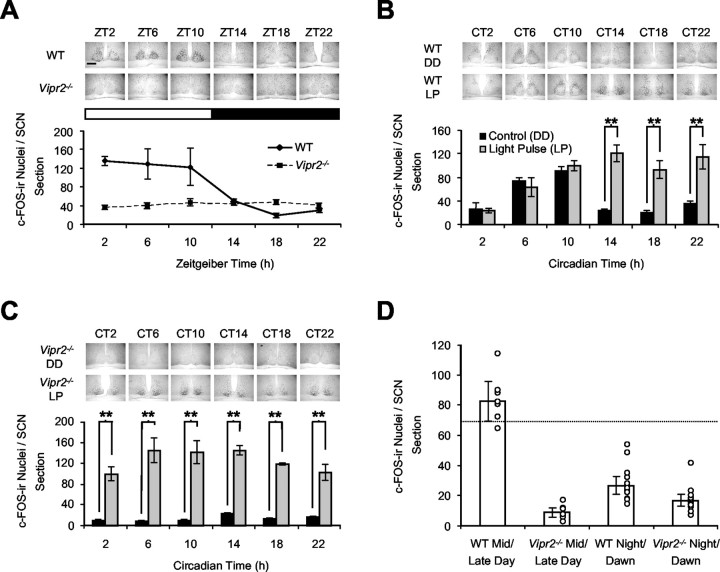Figure 3.
Diurnal, circadian, and gating of photic regulation of c-FOS in the SCN of WT mice but not Vipr2–/– mice. A, c-FOS-ir expression varied diurnally in the WT SCN; all day phases were significantly different from all night phases (a priori comparisons, p < 0.005 to p < 0.001). In the Vipr2–/– SCN, c-FOS-ir did not vary across the diurnal cycle, with low numbers of c-FOS-ir nuclei at all time points (all comparisons, p > 0.05). The light and dark bars represent lights on and off, respectively. B, c-FOS-ir in DD is rhythmically expressed across the circadian cycle in the WT SCN; mid and late subjective day phases were significantly different to all night and early day time points (p < 0.05 to 0.001). Light pulses (15 min) increased c-FOS-ir only during the subjective night in the WT SCN (p < 0.001). C, c-FOS-ir in the Vipr2–/– SCN did not vary over the circadian cycle (all comparisons, p > 0.05). Light pulses increased numbers of c-FOS-ir nuclei at all circadian phases (p < 0.001). D, Spontaneous c-FOS-ir expression in the SCN of WT and Vipr2–/– mice in DD at mid/late subjective day or subjective night/dawn. At all phases, levels of spontaneously expressed c-FOS-ir in the SCN of Vipr2–/– mice did not surpass the lower 95% CI (broken line) of peak c-FOS-ir expression during the mid/late subjective day in WT SCN. The open circles depict data points from individual animals. Plots in A-C depict the means ± SEM, and histograms in D are the means ± 95% CI. **p < 0.001. Scale bar, 50 μm.

